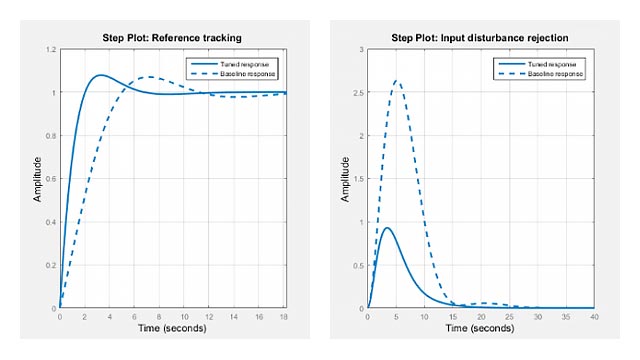pidTuner
Open PID Tuner for PID tuning
Syntax
pidTuner(sys,type)
pidTuner(sys,Cbase)
pidTuner(sys)
pidTuner
Description
pidTuner(launches thePID Tunerapp and designs a controller of typesys,type)typefor plantsys.
pidTuner(launches PID Tuner with a baseline controllersys,Cbase)Cbaseso that you can compare performance between the designed controller and the baseline controller. IfCbaseis apid,pidstd,pid2orpidstd2controller object, PID Tuner designs a controller of the same form, type, and discrete integrator formulas asCbase.
pidTuner(designs a parallel-form PI controller.sys)
pidTunerlaunches PID Tuner with default plant of 1 and proportional (P) controller of 1.
Input Arguments
|
Plant model for controller design.
If the plant has unstable poles, and
then you must specify the number of unstable poles in the plant. To do this, after opening PID Tuner, in thePlantmenu, select |
|
Controller type of the controller to design, specified as a character vector. The termcontroller type是指哪些术语controlle存在r action. For example, a PI controller has only a proportional and an integral term, while a PIDF controller contains proportional, integrator, and filtered derivative terms. 1-DOF Controllers
2-DOF Controllers
For more information about 2-DOF PID controllers generally, seeTwo-Degree-of-Freedom PID Controllers. 2-DOF Controllers with Fixed Setpoint Weights
For more detailed information about fixed-setpoint-weight 2-DOF PID controllers, seePID Controller Types for Tuning. Controller FormWhen you use the If
For more information about discrete integrator formulas, see the |
|
A dynamic system representing a baseline controller, permitting comparison of the performance of the designed controller to the performance of If
If |
Examples
Interactive PID Tuning of Parallel-Form Controller
Launch PID Tuner to design a parallel-form PIDF controller for a discrete-time plant:
Gc = zpk([],[-1 -1 -1],1); Gd = c2d(Gc,0.1); % Create discrete-time plant pidTuner(Gd,'pidf') % Launch PID Tuner
Interactive PID Tuning of Standard-Form Controller Using Integrator Discretization Method
Design a standard-form PIDF controller usingBackwardEulerdiscrete integrator formula:
Gc = zpk([],[-1 -1 -1],1); Gd = c2d(Gc,0.1); % Create discrete-time plant % Create baseline controller. Cbase = pidstd(1,2,3,4,'Ts',0.1,... 'IFormula','BackwardEuler','DFormula','BackwardEuler') pidTuner(Gd,Cbase) % Launch PID Tuner
PID Tuner designs a controller forGdhaving the same form, type, and discrete integrator formulas asCbase. For comparison, you can display the response plots ofCbasewith the response plots of the designed controller by clicking theShow baselinecheckbox in PID Tuner.
Tips
If
typeorCbasespecifies a one-degree-of-freedom (1-DOF) PID controller, thenpidTuner设计单位反馈回路的控制器illustrated:
If
typeorCbasespecifies a two-degree-of-freedom (2-DOF) PID controller, thenpidTunerdesigns a 2-DOF controller as in the feedback loop of this illustration:
PID Tuner has a default target phase margin of 60 degrees and automatically tunes the PID gains to balance performance (response time) and robustness (stability margins). Use theResponse timeorBandwidthandPhase Marginsliders to tune the controller's performance to your requirements. Increasing performance typically decreases robustness, and vice versa.
Select response plots from theResponsemenu to analyze the controller's performance.
If you provide
Cbase, checkShow baselineto display the response of the baseline controller.For more detailed information about using PID Tuner, seeDesigning PID Controllers with PID Tuner.
For interactive PID tuning in the Live Editor, see theTune PID ControllerLive Editor task. This task lets you interactively design a PID controller and automatically generates MATLAB®code for your live script.
Algorithms
For information about the MathWorks®PID tuning algorithm, seePID Tuning Algorithm.
Alternatives
You can open PID Tuner from the MATLAB desktop, in theAppstab. When you do so, use thePlantmenu in PID Tuner to specify your plant model.
For PID tuning at the command line, usepidtune. Thepidtunecommand can design a controller for multiple plants at once.
For interactive PID tuning in the Live Editor, see theTune PID ControllerLive Editor task. This task lets you interactively design a PID controller and automatically generates MATLAB code for your live script.
References
Åström, K. J. and Hägglund, T.Advanced PID Control, Research Triangle Park, NC: Instrumentation, Systems, and Automation Society, 2006.



